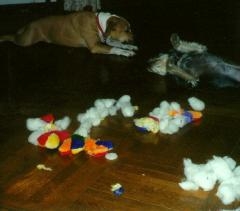Destructive Chewing

Chewing is essential for maintaining the health of your dog's teeth, jaws, and gums. Puppies especially have a strong need to chew to relieve the irritation and inflammation of teething. Dogs chew to relieve anxiety and boredom, as well as for entertainment. Your dog’s jaws are his tools for carrying objects and for investigating his surroundings. Essentially, a dog’s approach to all items in his environment is “Can I chew it?”
Chewing is Normal, Natural, and Necessary
Dogs generally sleep at night and in the middle of the day. However, chewing is your dog’s primary form of entertainment during his morning and late afternoon activity peaks. After all, there are only so many things your dog can do when left at home alone. He can hardly read a novel, telephone friends, or watch the soaps! Indeed, most chewing sprees stem from your dog's relentless quest for some form of occupational therapy to pass the time of day when left at home alone.
Chewing is a perfectly normal, natural, and necessary canine behavior. Prevention and treatment of destructive chewing focus on management and education—to prevent your dog from chewing inappropriate items and to redirect your dog's natural chewing-urge to appropriate, acceptable, and resilient chewtoys.
Prevent Destructive Chewing
When leaving home, confine your puppydog to a long-term confinement area, such as a single room—your puppydog’s playroom—with a comfortable bed, a bowl of water, a doggy toilet (if not yet housetrained), and nothing to chew but half a dozen freshly-stuffed chewtoys. Housetrained adult dogs may be confined (with their chewtoys) to a dog crate. When you return, instruct your dog to fetch his chewtoys so you can extricate the freeze-dried liver pieces and give them to your dog. Your dog will happily settle down and entertain himself with his chewtoys as soon as you leave in the morning, and he will be more inclined to search for chewtoys when he wakes up in anticipation of your afternoon return. This is important since most chewing activity occurs right after you leave home and right before you return.
When you are home, confine your puppy to her doggy den (crate) with nothing but a freshly-stuffed chewtoy for entertainment. Every hour on the hour (or at longer intervals with housetrained adult dogs), take your puppydog to her doggy toilet (see Housetraining blueprint), and if she goes, praise her and play some chewtoy games with her before putting her back in her crate with a freshly stuffed chewtoy.
The purpose of confinement is to prevent your dog from chewing inappropriate items around the house and to maximize the likelihood your dog will develop a chewtoy habit.
Redirect Chewing to Chewtoys
The confinement schedule described above optimizes self-training; your dog will train herself to chew chewtoys. In fact your dog will soon become a chewtoyaholic. With a good chewtoy habit, your puppy will no longer want to destroy carpets, curtains, couches, clothes, chair legs, computer disks, children's toys, or electrical cords. Your dog will be less likely to develop into a recreational barker. And also, your dog will happily settle down calmly and quietly and will no longer be bored or anxious when left alone.
You must also actively train your dog to want to chew chewtoys. Offer praise and maybe a freeze-dried liver treat every time you notice your dog chewing chewtoys. Do not take chewtoy chewing for granted. Let your dog know that you strongly approve of her newly acquired, appropriate, and acceptable hobby. Play chewtoy games with your dog, such as fetch, search, and tug-of-war.
Chewtoys should be indestructible and nonconsumable. Consumption of non-food items is decidedly dangerous for your dog's health. Also, destruction of chewtoys necessitates their regular replacement, which can be expensive. However, compared with the cost of reupholstering just one couch, $70 worth of chewtoys seems a pretty wise investment.
Kongs, Biscuit Balls, Squirrel Dudes, Busy Buddy Footballs, and sterilized long-bones are by far the best chewtoys. They are made of natural products, are hollow, and may be stuffed with food to entice your dog to chew them exclusively. To prevent your dog from porking out, ensure that you only stuff chewtoys with part of your dog's daily diet (kibble or raw food). Firmly squish a piece of freeze-dried liver in the small hole in the Kong, fill the rest of the cavity with moistened kibble, and then put the Kongs in the freezer. Voila, Kongsicles! As the kibble thaws, some falls out easily to reinforce your dog as soon as she shows interest. Other bits of kibble come out only after your dog has worried at the Kong for several minutes, thus reinforcing your dog's chewing over time. The liver is the best part. Your dog may smell the liver, see the liver, (and maybe even talk to the liver), but she cannot get it out. And so your dog will continue to gnaw contentedly at the Kong until she falls asleep.
Until your dog is fully chewtoy-trained, do not feed her from a bowl. Instead, feed all kibble, canned food, and raw diets from chewtoys, or handfeed meals as rewards when you notice your dog is chewing a chewtoy.
If you would like better insight into your dog’s chewing psyche, read Chapter 3, "It’s All Chew Toys to Them," in The Culture Clash by Jean Donaldson. If you require a more detailed description of chewtoy training, download BEFORE You Get Your Puppy. To chewtoy train your dog, you need a dog crate, a number of hollow chewtoys, and some freeze-dried liver treats. All of these products are available from your local pet store.




